The 2009 Parma Verdi Festival
Labels: festival, Giuseppe Verdi, opera
Labels: festival, Giuseppe Verdi, opera
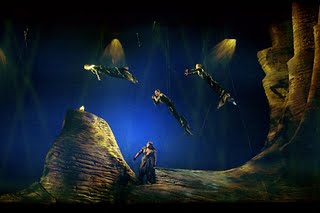 Richard Wagner dispatches the god Wotan, his most complex, conflicted and, therefore, fascinating character in the Ring, on the penultimate day of the Tetrology. On day three Siegfried, the troubled god, traverses the earth’s ‘broad back’ disguised as the wise and weary Wanderer. The lumbering young lummox of a hero that RW created in Siegfried splits the old man’s spear in two, destroying Wotan’s powers. He retreats. From then on it’s down to his daughter, Brunnhilde to sort out the ensuing mess.
Richard Wagner dispatches the god Wotan, his most complex, conflicted and, therefore, fascinating character in the Ring, on the penultimate day of the Tetrology. On day three Siegfried, the troubled god, traverses the earth’s ‘broad back’ disguised as the wise and weary Wanderer. The lumbering young lummox of a hero that RW created in Siegfried splits the old man’s spear in two, destroying Wotan’s powers. He retreats. From then on it’s down to his daughter, Brunnhilde to sort out the ensuing mess.
This has always struck me as an eccentric bit of story-telling: create a charismatic character, make us think it is his story, then get rid of him. Any Hollywood script guru would tell you this is dramatic folly.
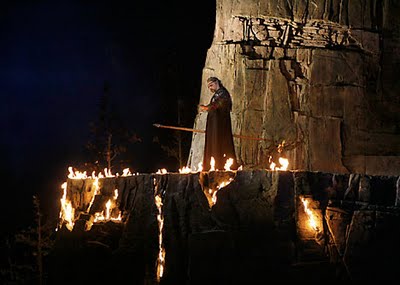 Nobody would dare change a note or syllable of the old German genius’s epic, of course. But in Seattle’s third outing of its 2001 ‘green Ring’, Greer Grimsley’s tireless, commanding Wotan/Wanderer dominated the cycle—despite that third day departure. When Grimsley first sang the role in the 2005 Seattle production, I was struck by his secure technique, stamina, vocal power and beauty of tone not unlike that of the great George London. This was a world-class performance, so Covent Garden please take note: next time Bryn Terfel pulls out of a Ring because his kid has broken a finger, try calling on this great American bass-baritone.
Nobody would dare change a note or syllable of the old German genius’s epic, of course. But in Seattle’s third outing of its 2001 ‘green Ring’, Greer Grimsley’s tireless, commanding Wotan/Wanderer dominated the cycle—despite that third day departure. When Grimsley first sang the role in the 2005 Seattle production, I was struck by his secure technique, stamina, vocal power and beauty of tone not unlike that of the great George London. This was a world-class performance, so Covent Garden please take note: next time Bryn Terfel pulls out of a Ring because his kid has broken a finger, try calling on this great American bass-baritone.
And then as Fricka there is Stephanie Blythe —probably the finest mezzo-soprano singing on any opera stage anywhere in the world today. Had Wagner given the Goddess of marriage and family a greater presence in the cycle this Ring would have been Blythe’s. Seattle made the wise decision to make the most of her glorious, lush, sumptuous mezzo and dramatic presence by bringing her back as the Götterdämmerung Waltraute and even as Second Norn.
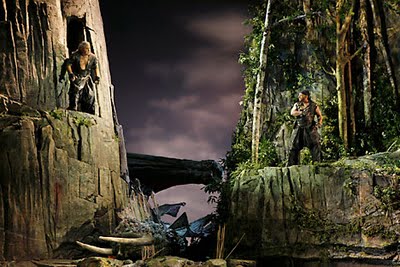
There were some significant newcomers to Ring roles this year , the most important being the arrivals of the American Janice Baird as Brunnhilde and the Danish Stig Anderson as Siegfried. The tall, slim Baird looks wonderful and is a fine actress; she has spectacular high notes and can create great dramatic excitement. She was, however, let down by a wobbly middle range and some off-pitch singing, most notable, alas, in the Immolation scene.
Stig Anderson had been indisposed by a viral infection during the first cycle but had soldiered on. By the time I saw him in the second cycle his performance went from a worrying, weary-sounding start in Siegfried to a magnificently sung death scene. That’s quite an achievement in this thankless role that makes so many vocal demands but provides so few dramatic rewards.
Another key newcomer, Australian Stuart Skelton made a stunning debut as a lyrical, romantic and youthful Siegmund, his voice ideally suited to the role.
San Franciscan Denis Petersen’s first Seattle Mime was also a magnificent debut. It is a tribute to the immense acting and singing talents of Petersen and the returning Richard Paul Fink as Alberich that the comic scene between the two wretched dwarfs in the second act of Siegfried was one of the most memorable of the whole cycle.
Kudos also to Chorusmaster, Beth Kirchhoff . The great male chorus of Vassals in Götterdämmerung, Act 2 sounded fantastic: virile, powerful and they acted well too.
Robert Spano, returning to the Seattle Opera pit for his second Ring since 2005, gave us a sweeping, lyrical Ring let down just occasionally by some erratic French horns.
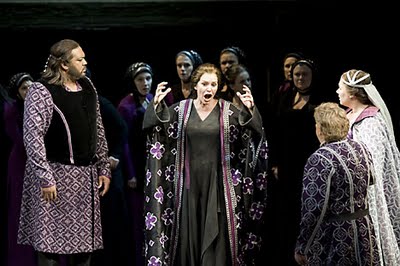
Director Stephen Wadsworth and designer Thomas Lynch have made few changes to their production. The ‘back to nature’ theme, so appropriate for the Pacific Northwest setting, remains a refreshing response to the many and varied, and invariably ugly European ‘concept’ Rings. One small quibble, and it takes us back to where we began with Wotan and Fricka: the Seattle team have decided that Fricka is not a shrew. That’s fine—Patrice Chereau came to the same conclusion in the Bayreuth Centenary production in 1976. But for my taste, Wadsworth has taken this idea a step too far. Wotan and Fricka constantly smooch, caress and gaze so moonily and sappily at each other that this writer started to wonder if they might not be better suited to a weekend at a Sandals resort for couples instead of going to live on Valhalla. But it’s a small flaw in what remains probably the loveliest Ring to be seen anywhere in the world.
Pour sa grande fête traditionnelle de cette année, le Festival Montréal baroque a concocté un menu bien particulier. Comme plat principal, la très belle musique de Purcell dont on célèbre cette année le 350e anniversaire de naissance. Selon la légende, la mort prématurée du célèbre compositeur aurait été causée par le chocolat. Il n’en fallait pas plus pour que l’on utilise ce thème attrayant pour illustrer les différents plats au menu musical. Et le choix n’était pas facile à faire dans les différentes approches chocolatées.
Le Millefeuille au chocolat illustre bien The Fairy Queen, le spectacle choisi pour le lancement du festival. Changeant continuellement de place, de personnage et de costume, comédiens et chanteurs étaient fort occupés dans une délirante mise en scène de Marie-Nathalie Lacoursière. La merveilleuse musique de ce semi-opéra, interprétée par La Bande Montréal Baroque, a été composée sur un livret adapté du Songe d’une nuit d’été, de Shakespeare. Et la magnifique partition est remplie d’humour et d’imagination. Même si une partie du texte a échappé aux francophones, dont l’oreille n’est pas habituée à Shakespeare, le grand talent des chanteurs et des comédiens du Repercussion Theatre n’a pas manqué de faire crouler de rire la salle entière. L’impressionnante distribution comprenait entre autres : Suzie LeBlanc, Monika Mauch, Laura McLean, Charles Daniels et Nathaniel Watson. Sous la direction de Mathias Maute, suivait le traditionnel défilé à l’extérieur, accueilli avec soulagement par la foule heureuse de prendre l’air, après avoir souffert de la grande chaleur qui régnait à l’intérieur.
Le premier concert de samedi soir, sous le titre Oh Henry! était consacré en grande partie à deux odes : L’Ode sur la mort d’henry Purcell de Blow et l’Ode Arise my Muse de Purcell. Cette dernière, composée pour l’anniversaire de la reine Marie est demeurée inachevée. Charles Daniels l’a terminée et est venu en faire la présentation. Les altos Daniel Taylor et Matthew White chantaient dans les deux pièces. Monika Mauch, Pascal Bertin, Charles Daniels et Nathaniel Watson les ont joints pour la seconde, accompagnés par l’Ensemble Caprice. Le concert débutait par l’entrée dramatique d’une procession d’instruments à vent et timbales, interprétant l’impressionnante March & Canzona, une musique funèbre pour la reine Marie. Il se terminait de la même façon, par la sortie des musiciens.
On avait choisi le Chocolat blanc pour le concert du Studio de musique ancienne qui présentait des compositions religieuses de Purcell. Sous la direction de Christopher Jackson, le SMAM a interprété sept Church anthems, dont le premier, Blow up the trumpet, écrit pour deux ensembles de dix voix, a été qualifié de véritable tour de force.
Commencé dans l’allégresse, le Festival se terminait dans la tragédie. Sous le titre Death by chocolate, l’Ensemble Masques interprétait le véritable opéra de Purcell, Didon & Énée, dont la bouleversante plainte de Didon demeure un des plus beaux airs de l’histoire de la musique. Dans une salle remplie à craquer et malgré le peu de moyens à leur disposition, musiciens et chanteurs ont présenté une magnifique prestation dans une mise en scène fort honnête de Pierre Saint-Amand. L’ensemble instrumental possède une belle sonorité au style baroque impeccable. Par les longues dissonances avant le lamento final, les musiciens ont fait ressortir la beauté de cette musique. La viole de gambe produisait des gémissements, donnant le ton à l’aria de Didon qui suit et devrait nous tirer des larmes, ce que Vicki St-Pierre a presque réussi à produire. Dans le rôle d’Énée, le baryton Dion Mazerolle a parfois un peu trop d’éclat, mais la fin du deuxième acte a été superbe. Tous les chanteurs possèdent une belle sonorité, mais il faut mentionner la réussite du chœur des sorcières, très convaincant par son cynisme et son sarcasme.
Les boulimiques avaient encore beaucoup à se mettre sous la dent. Entre autres, un concert du Flanders Recorder Quartet le vendredi soir et, le samedi, une soirée dansante qu’accompagnaient le Quatuor Franz Joseph et cinq autres musiciens. Les lève-tôt pouvaient se rendre au fameux concert présenté à 7 heures le matin du dimanche. Plusieurs autres activités étaient présentées en après-midi. Et pour les festivaliers qui voulaient échanger leurs impressions et rencontrer les artistes, le rendez-vous se situait au Café À Propos. Chaque représentation était suivie d’une dégustation de chocolats à la sortie. Une dégustation qui complétait joliment la soirée. A sweet ending !
Renée Banville
Labels: festival
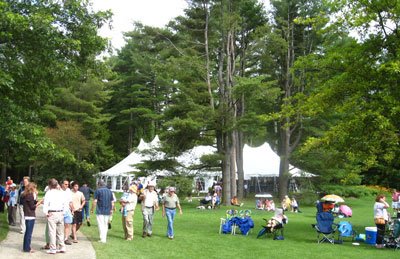 It has been years since I visited Tanglewood, the summer home of the Boston Symphony Orchestra. This year, with some encouragement from friends, Marita and I decided it was time to go back. We traveled from the Eastern Townships of Quebec – where we can usually be found at this time of year – taking a scenic route via secondary roads through Vermont so that we could visit Stowe for the first time.
It has been years since I visited Tanglewood, the summer home of the Boston Symphony Orchestra. This year, with some encouragement from friends, Marita and I decided it was time to go back. We traveled from the Eastern Townships of Quebec – where we can usually be found at this time of year – taking a scenic route via secondary roads through Vermont so that we could visit Stowe for the first time.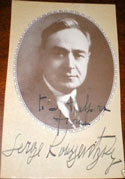 Incredibly, this mecca of music-making was conceived and inaugurated by conductor Serge Koussevitsky in 1936, during the depths of the depression. Shortly after its establishment, America was engulfed in a world war. The festival closed shop during the war years; rationing of rubber, steel and gasoline meant that few Americans had the means to travel hundreds of miles to a music festival. Fortunately, Tanglewood outlived the war and remains today a marvel of imagination and inspiration.
Incredibly, this mecca of music-making was conceived and inaugurated by conductor Serge Koussevitsky in 1936, during the depths of the depression. Shortly after its establishment, America was engulfed in a world war. The festival closed shop during the war years; rationing of rubber, steel and gasoline meant that few Americans had the means to travel hundreds of miles to a music festival. Fortunately, Tanglewood outlived the war and remains today a marvel of imagination and inspiration.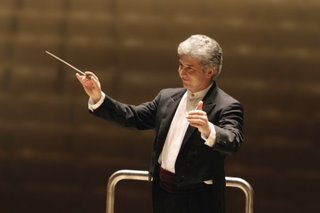 Peter Oundjian conducted the Boston Symphony at the Tanglewood Shed our first night there, with Joshua Bell playing Chausson’s “Poème” and Saint-Saens’ Introduction and Rondo Capriccioso. As a former violin soloist himself, Oundjian was an ideal accompanist, especially since Bell played with a lovely but somewhat unpredictable improvisatory quality. According to the program notes, the Chausson was last heard at Tanglewood in a performance by the same Joshua Bell in 1999. Few other violinists play it these days but it remains a unique, brooding masterpiece. We had good seats in about the 10th row on the extreme right of the stage. Not enough violins given our seat locations but otherwise very good sound.
Peter Oundjian conducted the Boston Symphony at the Tanglewood Shed our first night there, with Joshua Bell playing Chausson’s “Poème” and Saint-Saens’ Introduction and Rondo Capriccioso. As a former violin soloist himself, Oundjian was an ideal accompanist, especially since Bell played with a lovely but somewhat unpredictable improvisatory quality. According to the program notes, the Chausson was last heard at Tanglewood in a performance by the same Joshua Bell in 1999. Few other violinists play it these days but it remains a unique, brooding masterpiece. We had good seats in about the 10th row on the extreme right of the stage. Not enough violins given our seat locations but otherwise very good sound.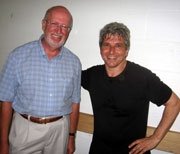 Earlier in the concert Oundjian had conducted Ravel’s “Alborado del gracioso” and after intermission led a very good performance of the familiar Mussorgsky-Ravel “Pictures at an Exhibition.” Particularly impressive was the tenor tuba solo in a very slow Bydlo; more expressive than I have ever heard it although there were some slips near the end. “The Great Gate of Kiev” was also slow and a little ponderous but the climaxes at the end with resplendent bells were spectacular.
Earlier in the concert Oundjian had conducted Ravel’s “Alborado del gracioso” and after intermission led a very good performance of the familiar Mussorgsky-Ravel “Pictures at an Exhibition.” Particularly impressive was the tenor tuba solo in a very slow Bydlo; more expressive than I have ever heard it although there were some slips near the end. “The Great Gate of Kiev” was also slow and a little ponderous but the climaxes at the end with resplendent bells were spectacular.Labels: festival, music, Tanglewood